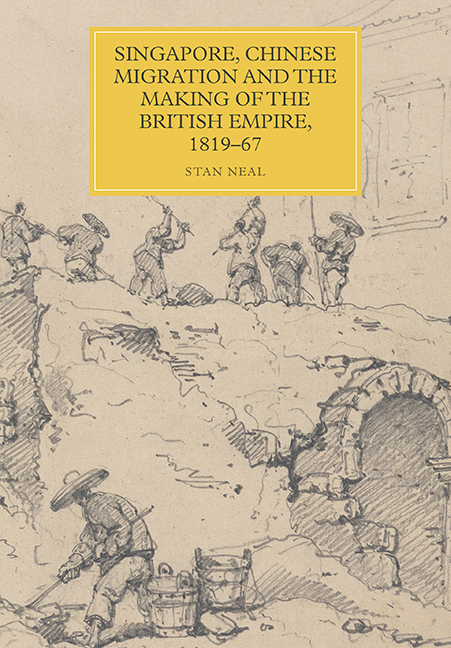Book contents
- Frontmatter
- Dedication
- Contents
- List of Illustrations
- Acknowledgements
- Language Usage
- Chronology: Singapore, the British Empire and Anglo-Chinese Relations, 1819–67
- Map
- Introduction
- Chapter 1 The Singapore Model
- Chapter 2 The Chinese Character: Race, Economics, Colonisation
- Chapter 3 Crossing the Indian Ocean: Chinese Labour in South Asia and Beyond
- Chapter 4 From Singapore to Sydney: Race, Labour and Chinese Migration to Australia
- Chapter 5 Hong Kong versus Singapore: The Dawn of Mass Migration
- Conclusion
- Bibliography
- Index
- Miscellaneous Endmatter
Chapter 3 - Crossing the Indian Ocean: Chinese Labour in South Asia and Beyond
Published online by Cambridge University Press: 26 June 2019
- Frontmatter
- Dedication
- Contents
- List of Illustrations
- Acknowledgements
- Language Usage
- Chronology: Singapore, the British Empire and Anglo-Chinese Relations, 1819–67
- Map
- Introduction
- Chapter 1 The Singapore Model
- Chapter 2 The Chinese Character: Race, Economics, Colonisation
- Chapter 3 Crossing the Indian Ocean: Chinese Labour in South Asia and Beyond
- Chapter 4 From Singapore to Sydney: Race, Labour and Chinese Migration to Australia
- Chapter 5 Hong Kong versus Singapore: The Dawn of Mass Migration
- Conclusion
- Bibliography
- Index
- Miscellaneous Endmatter
Summary
Perceptions of a Chinese character, one that was suited to provide a colonial labour force under British governance, had been developed in Singapore and disseminated by propaganda from Western merchants on the China coast. But what were the applications of the Chinese migrant labour beyond the limits of contact zones on the China coast or in Southeast Asia? Examining new experiments with Chinese labour migration in the 1830s and 1840s reveals the continuing construction of the Chinese character as a useful tool for colonial production. Chinese migrants were particularly desirable in different colonies that required skilled and unskilled, cheap and free labour. The timing of this phenomenon was crucial, with two connected changes re-shaping the British Empire's economic development from the 1830s. Parallel to the abolition of slavery in 1833, unremunerative British colonies underwent a rapid transformation into plantation-based ‘resource pools’. This process is neatly summarised by Alessandro Stanziani:
Growing demand in the West for raw materials and other tropical products led British colonizers to set up modern plantations as agro-industrial enterprises in several colonies of the British Empire, including India. Sugar, coffee or tea emerged as the most profitable products in the Caribbean, Fiji, Mauritius, Mala and Ceylon, as well as in Assam, Bengal, the northern Himalayas and southern parts of colonial India.
Without access to African slave labour or voluntary European colonists, such as those who populated Britain's settler colonies, the colonial administrators who tried to boost plantation agriculture and develop export economies looked to Chinese migration to Singapore as a model. Crucially, the desire for Chinese labour was not purely economic but part of a broader ideology of colonial improvement. As in Singapore, economic necessity and ideas about race were intertwined.
This chapter brings together three case studies, which demonstrate the different ways in which colonial authorities sourced Chinese labour for new colonial settings. The first case study is the development of tea planting experiments in Assam in the 1830s. In order to develop tea plantations for the production of tea for export to Britain, colonial projects in Assam recruited Chinese tea cultivators from both China and Singapore. The second case this chapter examines is the repeated attempts to introduce Chinese colonists to Ceylon in a period notable for increased metropolitan and economic pressure on Indian Ocean plantation colonies. The governorship of James Alexander Stewart-Mackenzie is a central concern.
- Type
- Chapter
- Information
- Publisher: Boydell & BrewerPrint publication year: 2019



